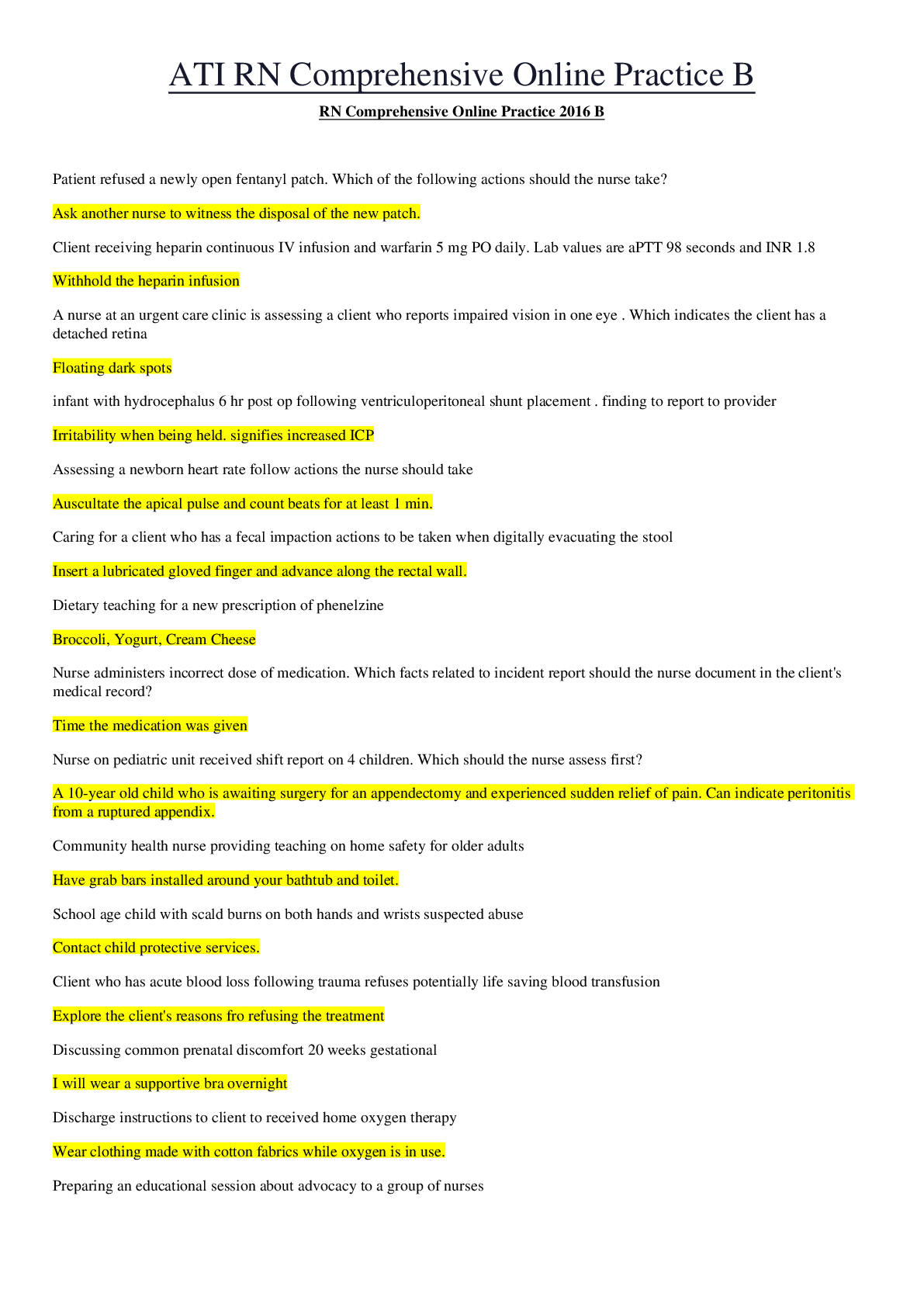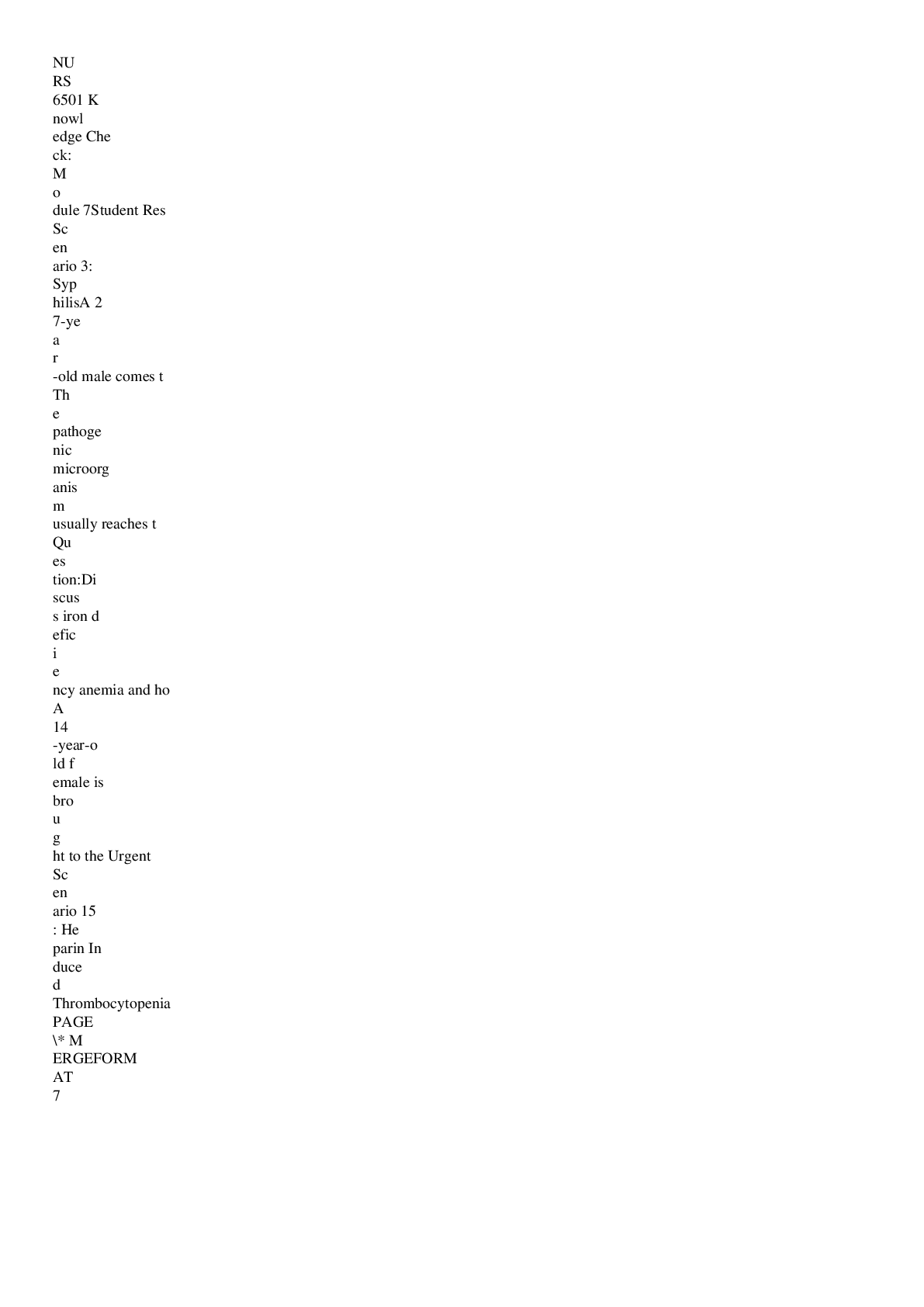NURS 6501 Knowledge Check Module 6
Document Content and Description Below
NURS 6501 Knowledge Check Module 6 2022 – Mercer County Community College Student Response This Knowledge Check reviews the topics in Module 6 and is formative in nature. It is worth 20 points... where each question is worth 1 point. You are required to submit a sufficient response of at least 2-4 sentences in length for each question. Scenario 1: Schizophrenia A 21-year-old male college student was brought to Student Health Services by his girlfriend who was concerned about changes in her boyfriend’s behaviors. The girlfriend says that recently he began hearing voices and believes everyone is out to get him. The student says he is unable to finish school because the voices told him he was not smart enough. The girlfriend relates episodes of unexpected rage and crying. Past medical history noncontributory but family history positive for a first cousin who “had mental problems”. Denies current drug abuse but states he smoked marijuana every day during his junior and senior years of high school. He admits to drinking heavily on weekends at various fraternity houses. Physical exam reveals thin, anxious disheveled male who, during conversations, stops talking, cocks his head and appears to be listening to something. There is poor eye contact and conversation is rambling. Based on the observed behaviors and information from girlfriend, the APRN believes the student has schizophrenia. Question 1 of 4: Describe the positive symptoms of schizophrenia and relate those symptoms to the case study patient. Positive symptoms of schizophrenia include hallucinations that may be auditory, olfactory, somatic-tactile, visual, voices commenting, and voices conversing. Delusions including delusion of being controlled, delusion of mind reading, delusion of reference, delusion of grandiosity, guilt, persecution, somatic thought broadcasting, thought insertion and thought withdrawal. Thought disorder symptoms include distractible speech, incoherence, illogicality, circumstantially, and derailment. Bizarre behaviors that include aggressiveness and agitated states, clothing appearance, repetitive stereotyped, and social and sexual behavior. The patient in the scenario exhibit signs of auditory hallucinations, disheveled appearance, and persecution. Question 2 of 4: Explain the genetics of schizophrenia. Schizophrenia is a heritable disorder. Schizophrenia is not a simple genetic disorder in which inherited disease alleles will always lead to illness. Schizophrenia likely involves several genes located on different chromosomes and differs from mendelian disorders, in which genes are fully penetrant and recognized as the primary cause of disease. Increased paternal age is associated with a greater risk of schizophrenia. The risk of schizophrenia is elevated in biologic relatives of persons with schizophrenia but not in adopted relatives. The risk of schizophrenia in first-degree relatives of persons with schizophrenia is 10%. If both parents have schizophrenia, the risk of schizophrenia in their child is 40%. Concordance for schizophrenia is about 10% for dizygotic twins and 40-50% for monozygotic twins. Question 3 of 4: The APRN reviews recent literature and reads that neurotransmitters are involved in the development of schizophrenia. What roles do neurotransmitters play in the development of schizophrenia? The onset of schizophrenia was initially hypothesized to stem from abnormally high concentrations of the brain neurotransmitter dopamine. This dopamine hypothesis of schizophrenia was proposed on the basis of pharmacologic studies showing that antipsychotic drugs were potent blockers of brain dopamine receptors. A strong correlation was found between the clinical potencies of first-generation antipsychotic drugs and their affinity for the dopamine D2 receptor. Another neurotransmitter system that may underlie the pathogenesis of schizophrenia is the excitatory neurotransmitter glutamate and its actions on the NMDA receptor subtype. The glutamate hypothesis of schizophrenia proposes that under activation of glutamate receptors contribute to schizophrenia. In schizophrenia, glutamate concentrations in the CSF are reduced along with in a decrease in cortical glutamate synthesis. Question 4 of 4: The APRN reviews recent literature and reads that structural problems in the brain may be involved in the development of schizophrenia. Explain what structural abnormalities are seen in people with schizophrenia. Advances in neuroimaging studies show differences between the brains of those with schizophrenia and those without this disorder. In people with schizophrenia, the ventricles are larger, decrease in brain volume in medial temporal areas, and changes in the hippocampus. Magnetic resonance imaging (MRI) studies show anatomic abnormalities in a network of neocortical and limbic regions and interconnecting white-matter tracts. Some studies using diffusion tensor imaging (DTI) to examine white matter found that 2 networks of white-matter tracts are reduced in schizophrenia. Brain imaging showed reductions in whole-brain volume and in left and right prefrontal and temporal lobe volumes in many people who are at high genetic risk for schizophrenia. The changes in prefrontal lobes are associated with increasing severity of psychotic symptoms. Scenario 2: Bipolar Disorder A 34-year-old female was brought to the Urgent Care Center by her husband who is very concerned about the changes he has seen in his wife for the past 3 months. He states that his wife has had been depressed and irritable, has complaints of extreme fatigue, has lost 10 pounds and has had insomnia. He has come home from work to find his wife sitting in front of the TV and not moving for hours. In the past few days, she suddenly has become very hyperactive, has been talking incessantly, has been easily distracted and seems to “flit from one thing to another.”. She hasn’t slept in 3 days. The wife went -- - - - - - - - - - - - - - - - - - - - - - - - -- Scenario 7: Obsessive-Compulsive Disorder (OCD) A 17-year-old male high school junior comes to the clinic to establish care. He recently moved from a relatively urban area to a very rural area and has just started his junior year in a new school. The mother states that she has noticed that her son has been frequently washing his hands and avoids contact with any dirty or soiled object. He uses paper towels or napkins over the knob on a door when opening it. According to the mother, this behavior has just appeared since moving. The patient, upon close questioning, admits that he is “grossed out” by some of the boys in the boys’ room since they use the toilet and do not wash their hand afterwards. He is worried about all the germs the boys are carrying around. Past medical history is noncontributory. Social history -lives with parents and 2 siblings in a house in a new town. Is an honors student. Based on these behaviors, The APRN thinks the patient has obsessive-compulsive disorder (OCD). Question 1 of 2: What is primary pathophysiology of OCD? Functional brain imaging studies have identified increase in blood flow and metabolic activity in the orbitofrontal cortex, limbic structures, caudate, and thalamus, with a trend toward right-sided predominance. There is a pathophysiological brain circuit that consists of the anterior thalamus, orbitofrontal cortex, dorsal anterior cingulate cortex, and predominately in the basal ganglia subregions of the caudate and putamen is involved in OCD. Question 2 of 2: Describe the role the dorsal anterior cingulate cortex (dACC) has in reinforcement of obsessive behaviors. Neuroimaging studies have demonstrated hyperactivity of the dACC in people with OCD as compared to controls. The dACC is thought to be a key center that receives negative emotion and reinforcing information and integrates that information to direct motivated behavior. [Show More]
Last updated: 1 year ago
Preview 1 out of 16 pages

Buy this document to get the full access instantly
Instant Download Access after purchase
Buy NowInstant download
We Accept:

Reviews( 2 )

by lrussell · 4 years ago
Thank you for the rating. by Martin Freeman. 4 years ago

by Martin Freeman · 4 years ago
$11.00
Can't find what you want? Try our AI powered Search
Document information
Connected school, study & course
About the document
Uploaded On
Nov 12, 2020
Number of pages
16
Written in
Additional information
This document has been written for:
Uploaded
Nov 12, 2020
Downloads
1
Views
136








 – University of the People.png)












